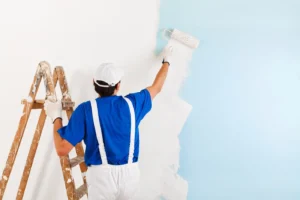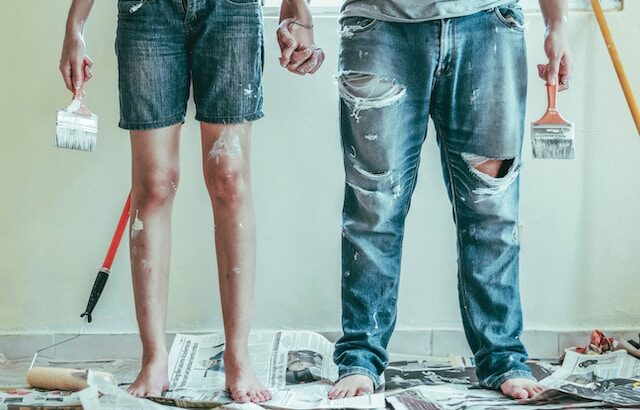Painting is a simple and cost-effective way to improve the aesthetics of your business. It also helps protect surfaces from damage and weathering.
However, commercial painting is a lot more complicated than painting a home. Commercial painters must work during business hours and adhere to strict safety protocols. Click https://maiseybrushworks.com/ to learn more.

The cost of commercial painting can vary significantly, depending on several factors. For one, there is the size of the building to consider. A bigger space will take longer to paint, increasing the overall cost. In addition, the type of paint used will also play a role in the price. It is important to find a company that uses high-quality paints. This will ensure that the paint job will last for a long time.
It is also important to factor in any preparation work that may be required. This could include removing dated popcorn ceilings or cleaning mildew-stained drywall. A commercial painter should be able to provide an estimate of these costs before beginning the project. Additionally, if the job requires special finishes such as faux finishing or trompe l’oeil (literally “trick of the eye”), those should also be included in the estimate.
Aside from the cost of the paint, there is the cost of labor. The hourly rate for painting is generally higher for commercial jobs than residential projects. In addition, there is the cost of equipment such as ladders, tarps, brushes, and a variety of other tools. Some painters will also charge an additional fee for cleaning up and hauling away trash.
Commercial painting can also be very time consuming. Often, businesses will hire contractors to work at night or during the weekends so that the project can be completed without disrupting business operations. This will increase the cost of the project, but it is a good way to avoid having to close down for too long.
When shopping for a commercial painting contractor, be sure to get several quotes. This will give you an idea of the average cost for a project of your size. Beware of companies that offer extremely low prices. These painters may not be as professional as they seem and may not do a good job on your project.
The last thing you want is to spend a lot of money on a commercial painting project that doesn’t stand up to the test of time. A poor quality paint job will not only look bad, but it will also cost you money in the long run when you have to repair it.
Painting is a trade that requires diligence and professionalism. If you want to grow your business, it’s important to maintain a solid reputation in your community. This will help you to attract new clients and keep existing ones. You can do this by offering excellent service, staying in touch with past customers, and being punctual on every project.
Commercial painters must have extensive experience in working with various surfaces. They must also know how to work with complex equipment, like power washers and sandblasters. In addition, they must be familiar with a variety of different types of paints and finishes. They may need to perform multiple coatings on the same surface, so it’s important to have a wide range of skills in order to get the job done quickly and efficiently.
Managing a commercial painting business requires a strong marketing strategy and a steady stream of new leads. Email and social media marketing campaigns can help you stay top of mind with potential clients and support your lead generation process. You should also consider developing a referral program for existing clients to help you get more jobs.
A good commercial painting contractor should have a solid understanding of building and construction. They should be able to communicate clearly with contractors, owners, and facility managers. This ensures that all parties understand each other and can provide input on the project. It’s also crucial that a commercial painting company have great attention to detail, so they can finish projects on time and within budget.
Many business owners rely on local references when choosing a commercial painting contractor. If a company has a lot of positive reviews, they are likely to be reliable and trustworthy. However, it’s important to read all of the reviews and make sure they are authentic. If the reviews sound too good to be true, it’s best to choose another contractor.
Another way to build a good reputation is through networking events and home improvement expos. Attending these events can help you connect with other home services business owners, such as drywallers and real estate agents. You can then exchange business cards with these people and agree to send each other referrals. This is a low-cost and effective way to advertise your business and attract new clients.
Painting contractors must take a number of safety measures to ensure the health and well-being of their employees. These include regularly reviewing and updating their risk assessment processes, as well as ensuring that all workers are trained on appropriate safety protocols. These measures help to create a culture of responsibility and care that leads to project success and client satisfaction.
One of the most common risks in commercial painting is chemical exposure. Paint products contain several chemicals that can be harmful if inhaled or come into contact with the skin. Therefore, painters should use a respirator when applying paint and follow other safety precautions. This includes wearing rubber gloves, washing up with soap and water after using the paintbrush, and not smoking or eating food while working. Additionally, painters should avoid using solvents that are flammable or toxic.
Another important aspect of safety is establishing a plan for working alone in other people’s homes. This may involve a safety check with the owner of the house and arranging for someone to call in case of an emergency. In addition, a painters’ work area should be clear of walking impediments and any hazardous materials should be clearly marked. It’s also a good idea to wear the appropriate PPE (personal protective equipment) when working alone.
In order to maintain a safe work environment, commercial painting contractors should employ appropriate cleaning and storage methods for their paints, solvents, and tools. They should also have a well-prepared emergency response plan that outlines the steps to take in the event of an accident or injury. The plan should include detailed instructions on how to contact emergency services, as well as the location of first aid supplies and equipment.
Ladders and scaffolding are commonly used on commercial painting projects, so it’s important to take measures to prevent accidents related to falls from heights. This includes making sure ladders are in good condition and that workers are properly trained on their use. Moreover, it’s a good idea to have a fall arrest system in place.
Another key aspect of commercial painting is using fast-drying, low- or no-VOC paints to protect customers and employees from harmful fumes. It’s also a good idea for companies to give employees and customers advance notice of any construction work that will be taking place. This will help to minimize disruption and confusion.
Commercial painting is a powerful way to transform your business’s atmosphere and create a lasting impression on clients. Professional painters know the importance of color psychology and branding in creating a welcoming environment that aligns with your company’s brand identity. They can also assist you in selecting the right color palette to stimulate productivity and promote a healthy work environment. They can offer tips on how to choose the right paint for your workspace and ensure that surfaces are properly prepared, resulting in a durable and aesthetically pleasing finish.
Traditional paints contain hazardous air pollutants (HAPs) and volatile organic compounds, or VOCs, which are released into the atmosphere during the painting process and even after the paint dries. These chemicals contribute to air pollution, which negatively impacts human health and harms natural ecosystems. In addition, HAPs and VOCs can contaminate water bodies when they are improperly disposed of. They may also react with ground-level ozone to form photochemical smog, which has been linked to respiratory problems.
Eco-friendly paints are made of non-toxic ingredients, and they eliminate harmful emissions and reduce waste production. They also help to promote a greener future and encourage the use of renewable resources. They’re also safer for painters and the people who live or work in painted spaces.
Commercial painters must be aware of the environmental impact of their work. They should use proper safety precautions and adhere to strict environmental standards when working on a project. For example, they must wear personal protective equipment and follow the manufacturer’s instructions on how to use it. They should also inspect ladders before use and always maintain three points of contact when using them. In addition, they must take the time to clean up any spills and debris.
Commercial painters must also demonstrate diligence, which means acting in a responsible manner and following through on promises. For example, they should be punctual and ensure that the project is completed on schedule. Punctuality demonstrates reliability and contributes to positive working relationships. In addition, painters should follow all relevant safety regulations when using ladders and working at heights.




